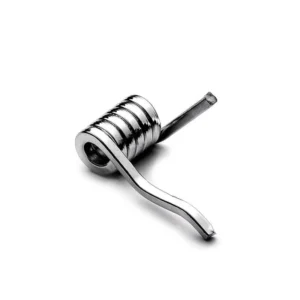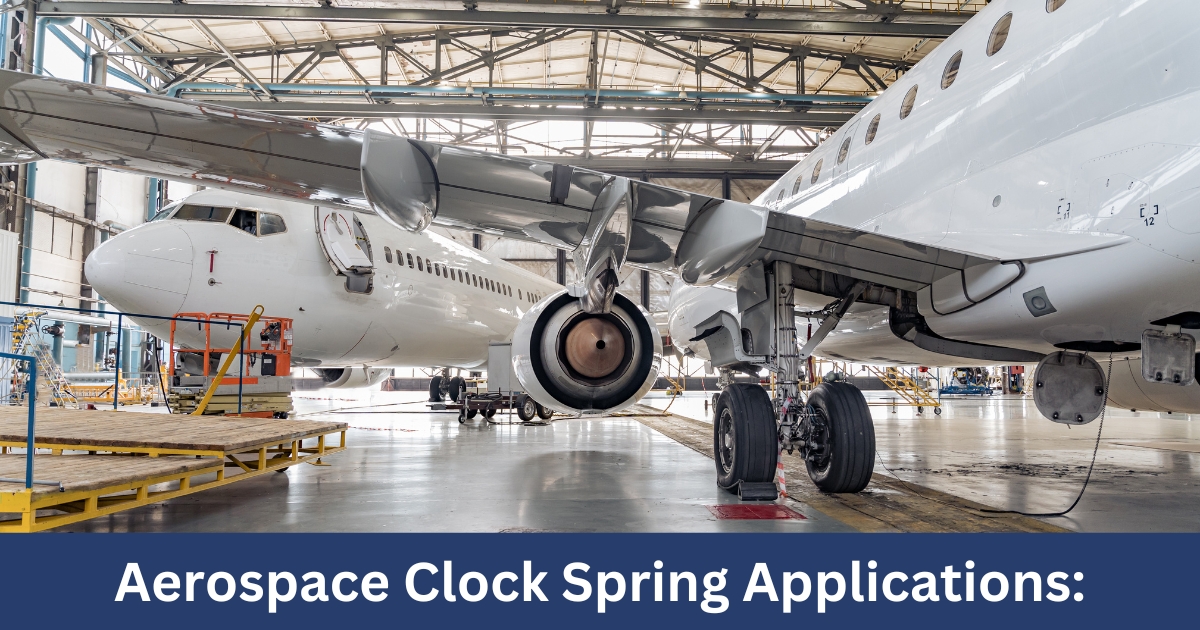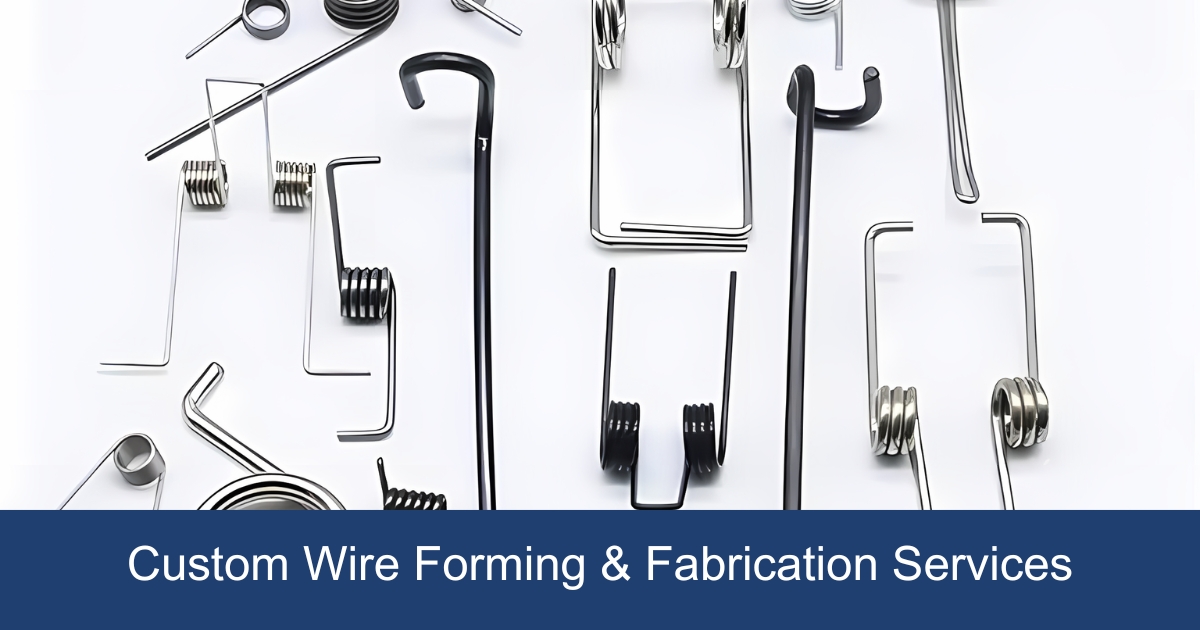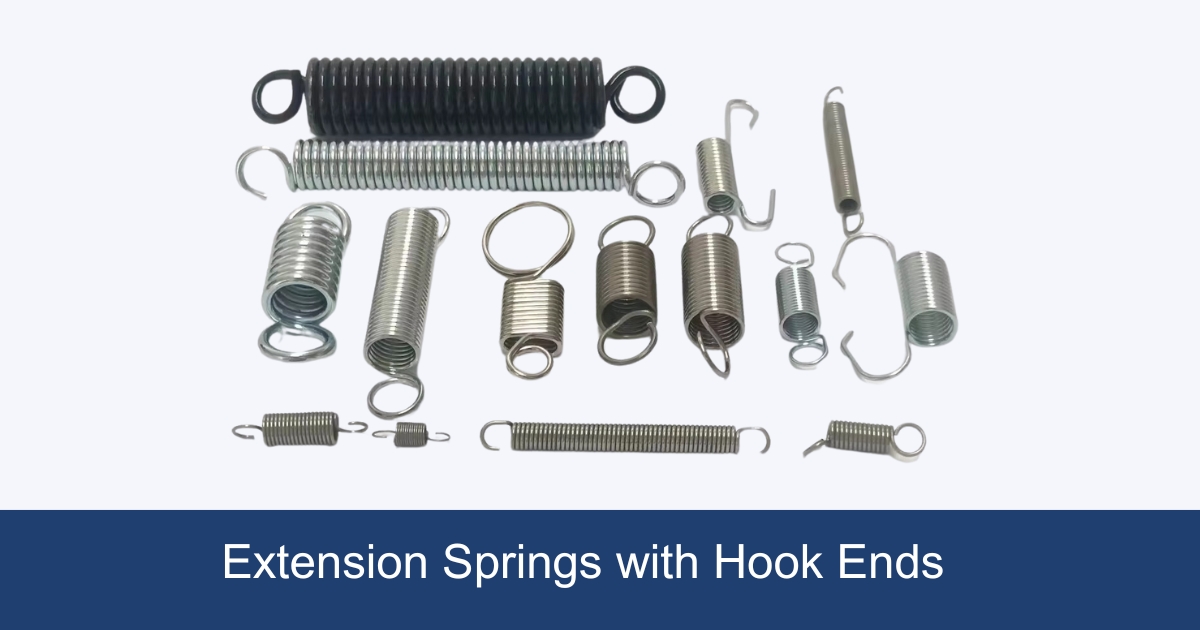Torsion springs, integral components in a myriad of applications from construction to aerospace, are critical for storing and releasing angular energy and maintaining rotational pressure between surfaces. These springs, made from various torsion spring materials including steel, stainless steel, and other alloys, are designed to bend without breaking, ensuring durability and a long lifespan.
This article delves into the properties that make certain materials suitable for torsion springs, including stainless steel 316 for its corrosion resistance and music wire for high strength. Exploring main types like spring steel and copper-based alloys, it examines their applications, benefits, and considerations in spring manufacturing, from wire diameter and outer diameter to constant force and inner diameter. The focus on spring materials offers insights into optimizing torsion spring performance across various industries, highlighting the importance of selecting the right torsion spring material for specific needs.

Material Properties for Torsion Springs
Torsion springs, pivotal in countless mechanisms, operate under bending stress, contrasting the common misconception of torsional stress. The choice of material, encompassing steel, stainless steel, and various alloys, significantly influences their functionality and durability. Key specifications such as inner and outer diameters, wire diameter, and body length, among others, are meticulously selected to match the spring’s intended application. These dimensions, including leg length and style, total coil, and pitch, are tailored to ensure optimal performance, highlighting the intricate design process behind torsion spring manufacturing.
- Specifications Overview:
- Inner Diameter: Essential for applications requiring the spring to slip over a mandrel.
- Outer Diameter: Critical when the spring must fit into a circular hole.
- Wire Diameter: Defines the thickness of the spring wire, directly impacting the spring’s strength.
- Body Length and Leg Length: Determine the overall size and operational range of the spring.
- Total Coil, Pitch, Winding Direction: Influence the spring’s flexibility and torque capacity.
- Leg Angle, Orientation, Style: Affect how the spring will connect and function within the mechanism.
The performance and longevity of torsion springs are governed by several properties and parameters, including spring index, angular deflection, maximum load, and spring rate. The spring index, a ratio indicating the spring’s coil tightness, along with the maximum deflection and load capacities, dictates the operational limits of the spring. Notably, the spring rate, representing the torque provided per unit of angular displacement, is a critical factor in selecting the appropriate spring for specific torque requirements. Moreover, the stress endured by the spring during operation is a paramount consideration, influencing the choice of material based on its tensile strength and durability.
- Performance Parameters:
- Spring Index: Influences the ease of bending and potential for stress concentration.
- Angular Deflection & Maximum Load: Define the operational range and torque capacity.
- Spring Rate: Determines the torque provided for each degree of rotation.
- Stress Considerations: Guide material selection to ensure resilience under operational conditions.
Incorporating these specifications and performance parameters into the design and selection process of torsion springs ensures that each spring is perfectly suited to its intended application, balancing strength, flexibility, and durability. The meticulous consideration of these factors exemplifies the complexity of torsion spring manufacturing and the importance of precise material selection.
Main Types of Materials Used in Torsion Springs
Torsion springs are fabricated from a diverse array of materials, each selected based on specific application requirements and desired properties such as strength, flexibility, and corrosion resistance. The primary materials used in the manufacturing of torsion springs include:
- Steel and High-Carbon Steel: Known for their durability and high tensile strength, these materials are commonly used in applications requiring robust performance.
- Stainless Steel (Types 302, 316, and 17-7 PH): Offers excellent corrosion resistance and is preferred in environments where springs are exposed to corrosive elements.
- Music Wire: Highly regarded for its high tensile strength and fatigue life, making it suitable for high-stress applications.
- Oil Tempered and Chrome Silicon: These materials are chosen for their superior strength and thermal resistance, ideal for high-temperature environments.
- Phosphor Bronze and Beryllium Copper: Known for their electrical conductivity and corrosion resistance, making them suitable for electronic applications.
- Exotic Materials (C276, Inconel 600 & 750, Monel): Used in specialized applications where extreme conditions are present, such as high temperatures or corrosive environments.
The types of torsion springs, including their configurations and operational mechanisms, are as follows:
- Single Torsion Helical Springs: Standard torsion springs that exert force in a circular motion, ideal for applications requiring rotational force.
- Double Torsion Helical Springs: Consist of two coiled sections connected and working in parallel, doubling the effective torque for applications requiring more substantial force.
- Torsion Bars: Solid bars twisted to apply torque or rotational force, commonly used in automotive suspension systems.
- Torsion Fibers: Utilize the torsional properties of materials at a microscopic level, often found in micro-electromechanical systems (MEMS).
- Spiral Wound Torsion Springs: Designed for applications requiring a large amount of torque in a compact space, such as clock mechanisms.
The selection of torsion spring materials and configurations is further influenced by various classes of metals and alloys, each offering distinct properties:
- Spring Steels: Provide high yield strength and are typically used in standard applications where durability is key.
- Stainless Steels (Type 302, Type 316, Type 17-7 PH): Offer excellent corrosion resistance and are suitable for harsh environmental conditions.
- Alloy Spring Steels: Include materials such as chrome silicon, known for their high strength and resistance to thermal stress.
- Copper-based Alloys: Such as phosphor bronze, preferred for their electrical conductivity and corrosion resistance.
- Nickel-based Alloys: Including Inconel and Monel, used in applications requiring high temperature and corrosion resistance.
This comprehensive range of materials and types allows for the customization of torsion springs to fit any design space envelope, with a wide selection of available spring materials and surface finishes to protect against corrosion and extreme temperature environments. The dimensional specifications, including wire diameter, leg position, and torque at deflection, are meticulously tailored to meet the unique demands of each application, ensuring optimal performance and longevity.
Carbon Steels in Torsion Springs
Carbon steel emerges as a favored choice in the realm of torsion spring materials, celebrated for its blend of strength, durability, and cost-effectiveness. This material’s appeal lies in its ability to withstand substantial pressures, a characteristic that is further enhanced through the tempering process. Tempering high carbon steels elevates their hardness levels, rendering them ideal for environments where high pressure and wear resistance are paramount. The versatility of high carbon steel allows for its application across a broad spectrum of commercial uses, providing a balance between performance and economy.
- Grades of High Carbon Steel Used in Torsion Springs:
- Music Wire: Renowned for its high tensile strength and excellent fatigue life.
- Hard Drawn: Offers a balance between tensile strength and flexibility.
- Oil Tempered (O.T.M.B.): Distinguished by its superior strength and thermal resistance.
Manufacturers like M & S Spring Company and Airedale Springs Ltd. are at the forefront of leveraging high carbon steels to craft torsion springs and wire forms tailored to specific project requirements. These companies offer a wide array of materials, ensuring that each spring is manufactured to precise specifications. This meticulous approach guarantees that the final product not only meets but exceeds the expectations in terms of strength, durability, and cost-efficiency. However, it is crucial to note that high carbon steel springs may not be the best fit for applications subject to extreme temperature fluctuations, as their performance could be compromised in such environments.
The selection of high carbon steel as a material for torsion springs underscores the importance of matching the material properties with the intended application. By choosing the appropriate grade of high carbon steel and employing specific manufacturing techniques, it is possible to achieve a product that offers an optimal blend of performance, longevity, and cost-effectiveness. These attributes make high carbon steel a compelling choice for a wide range of torsion spring applications, from commercial to industrial settings, where reliability and efficiency are key considerations.
Stainless Steel in Torsion Springs
In the realm of torsion spring materials, stainless steel stands out for its exceptional qualities, including corrosion resistance and strength. The most commonly utilized grades of stainless steel for spring wires include:
- 302: Known for its resilience and strength, making it suitable for a broad range of applications.
- 304: Offers a good balance between strength and corrosion resistance.
- 316: Distinguished by its superior corrosion resistance, especially against chlorides and marine environments.
- 17/7: Renowned for its high strength and durability, as well as excellent fatigue properties.
The process of manufacturing stainless steel spring wire is intricate, ensuring the material’s high quality and performance capabilities. This process encompasses several critical steps:
- Hot Rolling: The initial form of the steel is heated and then rolled to reduce its thickness.
- Annealing: This heat treatment process softens the steel, making it more workable and enhancing its ductility.
- Drawing: The steel is drawn through dies to reduce its diameter to the desired size, strengthening the material through cold working.
- Tempering: This final heat treatment step improves the mechanical properties of the steel, such as its strength and toughness.
An additional advantage of using stainless steel in the manufacturing of torsion springs is its environmental sustainability. Stainless steel spring wire is highly recyclable, which minimizes waste and supports eco-friendly manufacturing practices. This aspect not only contributes to the conservation of resources but also aligns with the growing emphasis on sustainable development within the industry.
By integrating these critical aspects, stainless steel emerges as a premier choice for torsion springs, offering a blend of durability, performance, and environmental sustainability. Its diverse grades cater to various application requirements, while the meticulous manufacturing process ensures the material’s reliability and effectiveness in demanding conditions.
Alloy Steels in Torsion Springs
Alloy steels in torsion springs offer a unique combination of properties that can significantly enhance the performance of these components in demanding applications. These materials are distinguished by their specific alloying elements, which are added to improve certain characteristics such as strength, hardness, wear resistance, and ability to withstand environmental conditions. The main types of alloy steels used in torsion springs include:
- Chrome Silicon:
- Properties: High tensile strength, excellent shock resistance, and superior heat resistance.
- Applications: Ideal for high-stress applications such as automotive engines and suspension systems.
- Chrome Vanadium:
- Properties: Offers increased toughness and high fatigue resistance.
- Applications: Commonly used in aerospace and defense mechanisms where reliability under extreme conditions is critical.
- Silicon-Manganese:
- Properties: Known for its high yield strength and thermal stability.
- Applications: Suited for industrial applications requiring durability and resistance to thermal fatigue.
The selection process for alloy steels in torsion springs involves considering the operational environment and the specific requirements of the application. Factors such as temperature extremes, potential for corrosive exposure, and the required lifespan of the spring play crucial roles in determining the most suitable alloy steel. For instance, Chrome Silicon is often preferred in automotive applications due to its resilience in fluctuating temperatures and its ability to maintain strength under repeated loads. On the other hand, Chrome Vanadium may be selected for aerospace applications where a combination of high strength and resistance to shock is necessary.
Furthermore, the manufacturing process of torsion springs from alloy steels involves precision engineering techniques to ensure optimal performance. This includes careful control of the heat-treating process to achieve the desired mechanical properties and the application of surface treatments to enhance corrosion resistance. The wire is typically cold drawn to the required diameter, followed by heat treatment to temper the steel, improving its performance characteristics.
In summary, the use of alloy steels in torsion springs enables the design and manufacture of components that are highly durable, capable of withstanding demanding operational conditions, and tailored to meet the specific needs of a wide range of applications. The choice of alloy steel is dictated by a combination of factors including the mechanical properties required, environmental conditions, and the specific application, ensuring that each torsion spring offers the best possible performance.
Considerations for Selecting Torsion Spring Materials
Selecting the appropriate material for torsion springs is a multifaceted process that necessitates a thorough understanding of the application environment, the physical demands on the spring, and the properties of potential materials. The following points outline key considerations in this selection process:
- Application-Specific Requirements:
- Customizable Options: Custom torsion springs, including double torsion springs, can be tailored to meet the unique needs of specific applications. This customization extends to surface finishes, which can significantly impact the spring’s performance in its intended environment.
- Environment Consideration: The operational environment of the spring dictates material selection. For corrosive environments, stainless steel or other corrosion-resistant metals are preferred to ensure longevity and maintain functionality.
- Manufacturing Capabilities: Advanced manufacturing equipment and processes, including CNC compression, self-monitoring, and coiling machinery, allow for precise fabrication of springs to meet exact specifications. This includes complete prototyping and tooling assistance services.
- Material Properties:
- Yield Strength, Ultimate Tensile Strength, and Fatigue Life: These material properties are critical in determining the spring’s ability to withstand operational stresses without failure. Materials with high yield and tensile strengths alongside robust fatigue life are ideal for applications demanding high durability and reliability.
- Wire Diameter Influence: The diameter of the wire used in the spring affects both the load it can handle and its flexibility. Thicker wires offer higher load capacities but at the cost of reduced flexibility, which may be a critical factor depending on the application.
- Impact of Manufacturing Process:
- Heat Treating Effects: The process of heat treating can significantly alter the material properties of the spring, enhancing hardness and strength. This process must be carefully controlled to achieve the desired material characteristics without compromising the spring’s performance.
In summary, the selection of torsion spring materials is a critical decision that impacts the spring’s performance, lifespan, and suitability for its intended application. By carefully considering the specific requirements of the application, the environmental conditions, and the properties of potential materials, manufacturers can ensure that the chosen torsion spring material offers the best balance of performance, durability, and cost-effectiveness.
Surface Treatments and Coatings
Surface treatments and coatings are pivotal in enhancing the performance and longevity of torsion springs, especially in challenging environments. The choice of coating can significantly impact corrosion resistance, durability, and conductivity, making it an essential consideration in spring design and manufacturing. Below are the key options and their benefits:
Coating Options and Benefits:
- Zinc Plating: Offers excellent corrosion resistance; commonly used for its protective and aesthetic properties.
- Powder Coating: Provides a durable, corrosion-resistant finish available in a wide range of colors for unique identification or decorative purposes.
- Black Oxide: Enhances corrosion resistance and reduces light reflection, also used for aesthetic improvements.
- Passivation: Removes iron deposits from stainless steel, adding a protective layer to guard against corrosion.
- Electroless Plating: Deposits nickel on the substrate without electric current, offering uniform coverage and excellent corrosion resistance.
Specialized Treatments for Enhanced Performance:
- Electropolishing: Smoothens and polishes metal surfaces, primarily stainless steel, for improved corrosion resistance and aesthetic appeal.
- Shot Peening: Induces compressive stresses on the surface, significantly increasing fatigue strength.
- Tumbling: Provides a brighter finish and deburrs metals, enhancing the aesthetic and functional quality of springs.
Selective Coatings for Specific Needs:
- Organic Zinc Flake Coatings: Known for exceptional corrosion resistance without the risk of hydrogen embrittlement, suitable for high-stress applications.
- Teflon PTFE: A fluoropolymer coating that excels in reducing noise and enhancing corrosion resistance, ideal for applications requiring silent operation.
- Zinc Phosphate Coating: Offers excellent lubricity and corrosion resistance, reducing friction between spring components.
- Thin-Film Coatings: Provide low-friction properties, minimizing wear and the risk of galling, perfect for high-precision mechanisms.
Incorporating the appropriate surface treatment or coating can significantly extend the functional life of torsion springs by protecting against corrosion and extreme temperatures. Moreover, treatments such as electropolishing and shot peening not only improve the surface quality but also enhance the mechanical properties of the springs. The selection of coatings is influenced by the application environment, desired properties, and the specific material used in the spring, ensuring optimal performance across a broad spectrum of uses.
Composite and Non-Metallic Materials
In the exploration of torsion spring materials, the advent of composite and non-metallic materials marks a significant evolution. These materials bring forth unique properties that can be advantageous in specific applications where traditional metals might not be the optimal choice. The following points outline the key aspects of composite and non-metallic materials used in torsion springs:
- Composite Materials:
- Fiberglass: Offers high strength and low weight, making it suitable for applications where reducing the overall weight is critical.
- Carbon Fiber: Known for its exceptional strength-to-weight ratio and stiffness, carbon fiber is ideal for high-performance applications.
- Kevlar®: Provides excellent tensile strength and is used in applications requiring resistance to environmental degradation.
- Non-Metallic Materials:
- Polymer Springs: Made from high-performance plastics, these springs are corrosion-resistant and can operate in chemically aggressive environments.
- Silicone and Rubber: These materials are used in applications requiring a wide range of temperature tolerance and flexibility.
The choice between composite, non-metallic, and traditional metal materials for torsion springs hinges on several factors, including:
| Material Type | Advantages | Common Applications |
|---|---|---|
| Composite Materials | High strength-to-weight ratio, corrosion resistance | Aerospace, automotive, marine |
| Non-Metallic Materials | Chemical resistance, wide temperature range | Chemical processing, medical devices |
This comparison underscores the importance of material selection in torsion spring design, emphasizing that the optimal material depends on the specific requirements of the application, including environmental conditions, load requirements, and desired lifespan. Composite and non-metallic materials, with their unique properties, offer viable alternatives to traditional metals, expanding the possibilities for torsion spring applications.
Conclusion
The selection of the ideal torsion spring material, therefore, hinges on a comprehensive understanding of the specific applications, environmental conditions, and operational demands. By meticulously considering factors such as material strength, flexibility, corrosion resistance, and the impact of manufacturing processes, designers and engineers can ensure optimal performance and longevity of torsion springs. This intricate selection process not only reinforces the importance of precision in material choice but also underscores the potential for innovative applications and sustainability in the field of torsion spring manufacturing.
FAQs
What Material is Best for Crafting Springs?
High Carbon Steels are highly regarded for spring manufacturing due to their impressive hardness levels and resistance to wear and tear. For low-stress applications, hard-drawn wires are an economical choice, whereas materials with higher tensile strength are preferred for high-stress applications, albeit at a higher cost.
Which Material is Ideal for a Tension Spring?
Chrome vanadium stands out as the most robust and durable among spring steels, boasting exceptional fatigue resistance. Music wire, a high-carbon steel alloy, is noted for its good fatigue life and capacity to endure high stresses, though it tends to be brittle. Stainless steel, known for its corrosion resistance, is capable of withstanding extreme environments and temperatures.
What is the Strongest Spring Material Available?
Music wire, or piano wire, a type of high carbon steel, is recognized as the strongest material for springs. It exhibits high tensile strength, allowing it to bear considerable stress and deformation without breaking.
How Should I Select a Spring Material?
When choosing a material for wire forms and springs, it is crucial to consider the mechanical properties, corrosion resistance, temperature behavior, and cost-effectiveness of the materials. These factors will guide you in selecting the most appropriate material for your specific needs.



